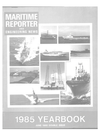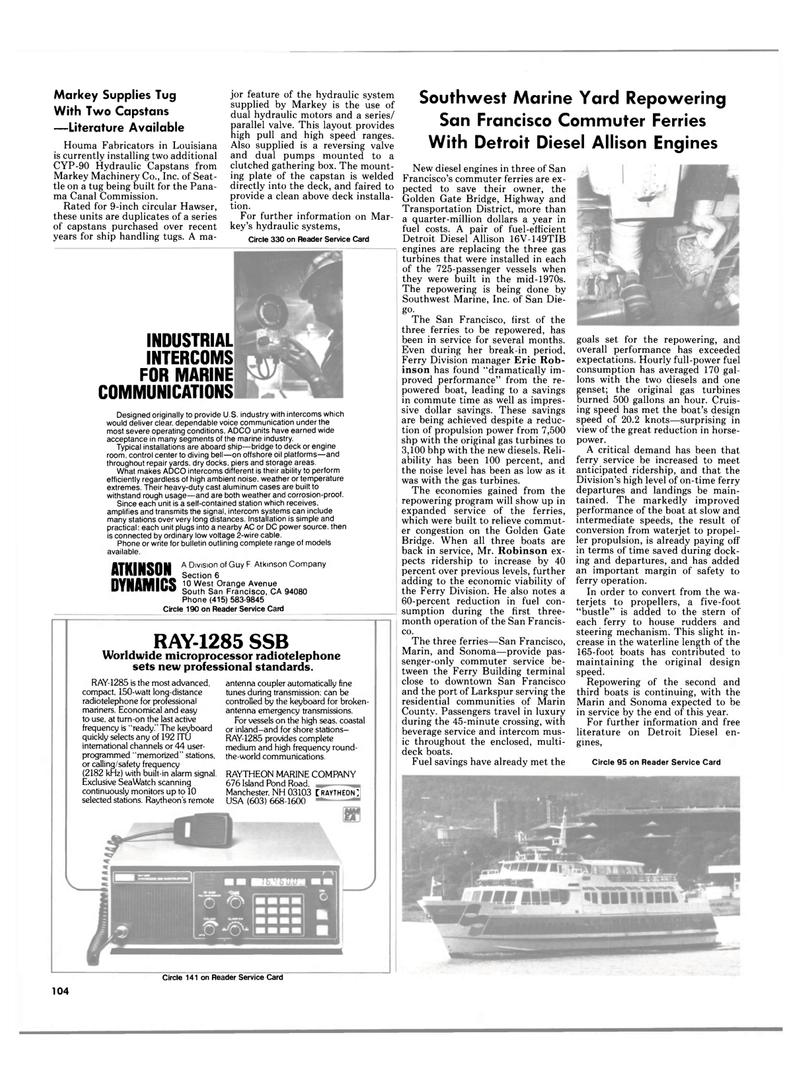
Page 106: of Maritime Reporter Magazine (June 1985)
Read this page in Pdf, Flash or Html5 edition of June 1985 Maritime Reporter Magazine
Markey Supplies Tug
With Two Capstans —Literature Available
Houma Fabricators in Louisiana is currently installing two additional
CYP-90 Hydraulic Capstans from
Markey Machinery Co., Inc. of Seat- tle on a tug being built for the Pana- ma Canal Commission.
Rated for 9-inch circular Hawser, these units are duplicates of a series of capstans purchased over recent years for ship handling tugs. A ma- jor feature of the hydraulic system supplied by Markey is the use of dual hydraulic motors and a series/ parallel valve. This layout provides high pull and high speed ranges.
Also supplied is a reversing valve and dual pumps mounted to a clutched gathering box. The mount- ing plate of the capstan is welded directly into the deck, and faired to provide a clean above deck installa- tion.
For further information on Mar- key's hydraulic systems,
Circle 330 on Reader Service Card
INDUSTRIAL
INTERCOMS
FOR MARINE
COMMUNICATIONS
Designed originally to provide U.S. industry with intercoms which would deliver clear, dependable voice communication under the most severe operating conditions, ADCO units have earned wide acceptance in many segments of the marine industry.
Typical installations are aboard ship—bridge to deck or engine room, control center to diving bell—on offshore oil platforms—and throughout repair yards, dry docks, piers and storage areas.
What makes ADCO intercoms different is their ability to perform efficiently regardless of high ambient noise, weather or temperature extremes. Their heavy-duty cast aluminum cases are built to withstand rough usage—and are both weather and corrosion-proof.
Since each unit is a self-contained station which receives, amplifies and transmits the signal, intercom systems can include many stations over very long distances. Installation is simple and practical: each unit plugs into a nearby AC or DC power source, then is connected by ordinary low voltage 2-wire cable.
Phone or write for bulletin outlining complete range of models available.
ATKINSON
DYNAMICS
A Division of Guy F Atkinson Company
Section 6 10 West Orange Avenue
South San Francisco, CA 94080
Phone (415) 583-9845
Circle 190 on Reader Service Card
RAY-1285 SSB
Worldwide microprocessor radiotelephone sets new professional standards.
RAY-1285 is the most advanced, compact, 150-watt long-distance radiotelephone for professional mariners. Economical and easy to use. at turn-on the last active frequency is "ready." The keyboard quickly selects any of 192 ITU international channels or 44 user- programmed "memorized" stations, or calling/safety frequency (2182 kHz) with built-in alarm signal.
Exclusive SeaWatch scanning continuously monitors up to 10 selected stations. Raytheon's remote antenna coupler automatically fine tunes during transmission; can be controlled by the keyboard for broken- antenna emergency transmissions.
For vessels on the high seas, coastal or inland-and for shore stations-
RAY-1285 provides complete medium and high frequency round- the-world communications.
RAYTHEON MARINE COMPANY 676 Island Pond Road.
Manchester. NH 03103 [RAYTHEON]
USA (603) 668-1600
Southwest Marine Yard Repowering
San Francisco Commuter Ferries
With Detroit Diesel Allison Engines
New diesel engines in three of San
Francisco's commuter ferries are ex- pected to save their owner, the
Golden Gate Bridge, Highway and
Transportation District, more than a quarter-million dollars a year in fuel costs. A pair of fuel-efficient
Detroit Diesel Allison 16V-149TIB engines are replacing the three gas turbines that were installed in each of the 725-passenger vessels when they were built in the mid-1970s.
The repowering is being done by
Southwest Marine, Inc. of San Die- go.
The San Francisco, first of the three ferries to be repowered, has been in service for several months.
Even during her break-in period,
Ferry Division manager Eric Rob- inson has found "dramatically im- proved performance" from the re- powered boat, leading to a savings in commute time as well as impres- sive dollar savings. These savings are being achieved despite a reduc- tion of propulsion power from 7,500 shp with the original gas turbines to 3,100 bhp with the new diesels. Reli- ability has been 100 percent, and the noise level has been as low as it was with the gas turbines.
The economies gained from the repowering program will show up in expanded service of the ferries, which were built to relieve commut- er congestion on the Golden Gate
Bridge. When all three boats are back in service, Mr. Robinson ex- pects ridership to increase by 40 percent over previous levels, further adding to the economic viability of the Ferry Division. He also notes a 60-percent reduction in fuel con- sumption during the first three- month operation of the San Francis- co.
The three ferries—San Francisco,
Marin, and Sonoma—provide pas- senger-only commuter service be- tween the Ferry Building terminal close to downtown San Francisco and the port of Larkspur serving the residential communities of Marin
County. Passengers travel in luxury during the 45-minute crossing, with beverage service and intercom mus- ic throughout the enclosed, multi- deck boats.
Fuel savings have already met the goals set for the repowering, and overall performance has exceeded expectations. Hourly full-power fuel consumption has averaged 170 gal- lons with the two diesels and one genset; the original gas turbines burned 500 gallons an hour. Cruis- ing speed has met the boat's design speed of 20.2 knots—surprising in view of the great reduction in horse- power.
A critical demand has been that ferry service be increased to meet anticipated ridership, and that the
Division's high level of on-time ferry departures and landings be main- tained. The markedly improved performance of the boat at slow and intermediate speeds, the result of conversion from waterjet to propel- ler propulsion, is already paying off in terms of time saved during dock- ing and departures, and has added an important margin of safety to ferry operation.
In order to convert from the wa- terjets to propellers, a five-foot "bustle" is added to the stern of each ferry to house rudders and steering mechanism. This slight in- crease in the waterline length of the 165-foot boats has contributed to maintaining the original design speed.
Repowering of the second and third boats is continuing, with the
Marin and Sonoma expected to be in service by the end of this year.
For further information and free literature on Detroit Diesel en- gines,
Circle 95 on Reader Service Card 104
Circle 141 on Reader Service Card

 105
105

 107
107
